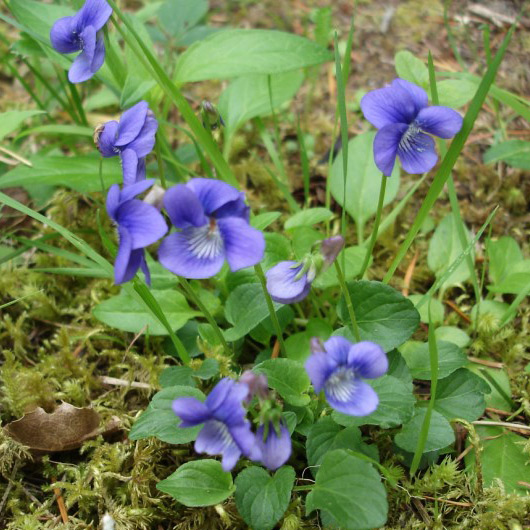Early Blue Violet
Viola adunca J.E. Smith var. adunca (V. adunca var. bellidifolia [Greene] Harrington, V. bellidifolia Greene)

overview
Perennial from short to long, slender rhizomes. Usually stemless in the early part of the season, later developing aerial stems up to 10 cm tall. Starts to flower early in the growing season. Leaves generally oval to heart-shaped, hairy to hairless, blades to 3 cm long with fine round-toothed margins. Stipules reddish-brown or with reddish-brown flecks, narrowly lance-shaped margins slender-toothed or somewhat ragged. Flowers to 1.5 cm long, with a slender spur half as long as the lowest petal, petals blue to deep violet, the lower three often white at base and purple-pencilled, and the lateral pair white-bearded. Fruits small capsules opening explosively by three valves (Pojar and MacKinnon, 1994). Photo by Dave Polster.
family
Violaceae
ecological setting
Dry to moist meadows, open woods, grasslands and open, disturbed ground from lowlands to near timberline (Pojar and MacKinnon, 1994).
soil texture
Medium textured soils.
nutrients
Nitrogen-medium soils (Klinka et al., 1995).
soil reaction salinity
Moderately acidic to mildly alkaline.
moisture regime
Very dry to moderately dry (Klinka et al., 1995).
shade tolerance
Shade intolerant to mildly shade tolerant (Klinka et al., 1995).
successional status
Climax in meadows and open woodlands. Seral species on moister disturbed ground.
bec zone subzone status
Open woodlands and meadows within Garry Oak ecosystems.
site rehabilitation
Probably not a practical candidate species.
wildlife
Key food species for the larvae of the Silverspot butterfly.
landscaping
Native violets "can produce the right substitute with a restrained beauty" to exotics such as pansies. Viola adunca grows in such a range of habitats that many natural variants occur. "This is an easy, dependable and lovely plant for rather dry, open woods or lower reaches of the rockery in sun or partial shade" (Krukeberg, 1996).
other uses
Leaves and flowers can be eaten raw in salads, used as potherbs or made into tea. Flowers and leaves have long been used in various herbal remedies such as poultices, a relief for coughs, colds and lung congestion, and as a laxative (Pojar and MacKinnon, 1994).
flowering time
Early summer
fruit ripening time
Mid-summer
seed collection time
Mid-summer
crop intervals
Annual
collection and abstraction
Seed capsules open explosively to disperse seed so "bagging" is recommended to avoid seed loss.
fruit seed dormancy treatment
Sow seed in early spring into flats or a cold frame and cover lightly. Germination of other violet species occurs in 10-20 days at 18-22º C (Bryant, 1995). Prick the seedlings out into individual pots when they are large enough to handle and plant out in late summer.
vegetative propagation
| Method | Success Rate | Time of Collection |
|---|---|---|
| Softwood cuttings | Good Success rate for other violet species from stem and leaf cuttings (Bryant, 1995) | Summer to early fall |
| Semi-hardwood cuttings | N/A | N/A |
| Hardwood cuttings | N/A | N/A |
| Root cuttings | Moderate | Autumn |
| Suckers | N/A | N/A |
| Plant division | Moderate to good | Autumn |
additional info and photos
For more information and pictures, visit the E-Flora BC website at www.eflora.bc.ca.www.eflora.bc.ca